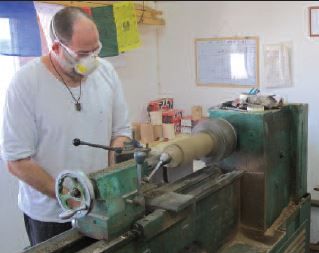Spreading Love with Prayer Wheels
To the east of the dining room on Kibbutz Ein Hashofet, just below the cylindrical grain silo in one of the old chicken runs, Micha and Ayelet are busy making prayer wheels. Micah works on a lathe in the back room, while Ayelet concentrates on etching Hebrew lettering onto one nearly completed. Prayer Wheels are not something one would expect to find being produced on a highly secular kibbutz, but times have changed over the decades with several kibbutz members now wearing kippot s, weekly yoga classes and Torah studies, and several practicing Buddhists, Micha and Ayelet among them.
Micha, in his early 40s, and his partner Ayelet Cohen from Kibbutz Yechiam, both believe it was destiny for them to create prayer wheels together. In early 2009, the Tibetan Buddhist teacher, Garchen Rinpoche, was conducting a seminar in Israel and, explains Ayelet, "Garchen held a prayer wheel that was effortlessly spinning, with gold lettering and a crystal on top. Micha and I both looked at each other and knew we needed to make one."
Within several months they had constructed their first wooden one; the inception of their home business.
"Making prayer wheels is among the holiest thing a Buddhist can do; its purpose is to spread joy, love and compassion," Micha explains. "For seven kilometers in every direction, all beings are freed from the lower levels and from seven rebirths. Just to see a prayer wheel is a huge blessing."
The workshop tables and shelves display their hand-held models, table-top prayer wheels, small necklace versions, as well as wooden dreidels, bowls, candle holders, boxes, rings, and wall ornaments. The table-top versions are particularly striking, some egg shaped with delicate spires, others cylindrical of plain wood, etched, or stained with color. The necklace prayer wheels run about $25-$30; hand-held and table top ones are priced from $100-$300.
A variety of woods are employed, including local olive wood, cherry, walnut, mahogany, African walnut, scrap wood from the nearby forest, and purple heart wood with a lovely lavender tint. In one corner of the shop stand pieces of wood, which take about two years to fully dry.
Micha explained the curious synchronicity of how shortly after they began making prayer wheels, a friend from the neighboring kibbutz Mishmar Ha'Emek, approached them to ask if they would like some copies of microfilm printed with Buddhist mantras of compassion. Within one frame of film are some 11,000 seven-line mantras.
"It was such stroke of luck, or karma," Micha says as he showed me the large roll of microfilm. Pieces of the film are cut, rolled up tight and placed inside each prayer wheel. Inside each Buddhist prayer wheel are about 10,000,000 to 50,000,000 mantras.
Among the prayer wheels, I spot several etched with crosses, others with Hebrew or Arabic lettering. A couple of years ago, Micha and Ayelet made the decision to expand the concept into other faiths, where prayers wheels were not historically part of the tradition. Inside the Jewish prayer wheels is written the Shema or Ana B'koach prayers. In the Christian ones, it's the Lord's Prayer in Greek and Latin. They will create a prayer wheel for any spiritual faith requested.
Non-Orthodox Jews have reacted well to the prayer wheels; a woman in Caesarea has made multiple orders for gifts and many are shipped to New York.
Micha showed a Jewish man of the Breslever tradition the prayer wheel and he loved the idea, but said they must not write anything holy on the outside, and that the prayer inside the necklace version must be properly sealed and protected so that it can be worn in the bedroom and the bathroom, as is in keeping with Jewish law. Micha also met with a Chabad-Lubavitcher rabbi who was encouraging and said that if one had one they "must never stop spinning the prayer wheel."
When I asked how to keep making prayer wheels from becoming boring, Micha replied, "I try to remember beginner's mind; what it was like when I made the very first one. It was so sacred and holy. I try to keep that attitude alive, and also remember that the prayer wheel I am making will be with one special person for many years."











Comments